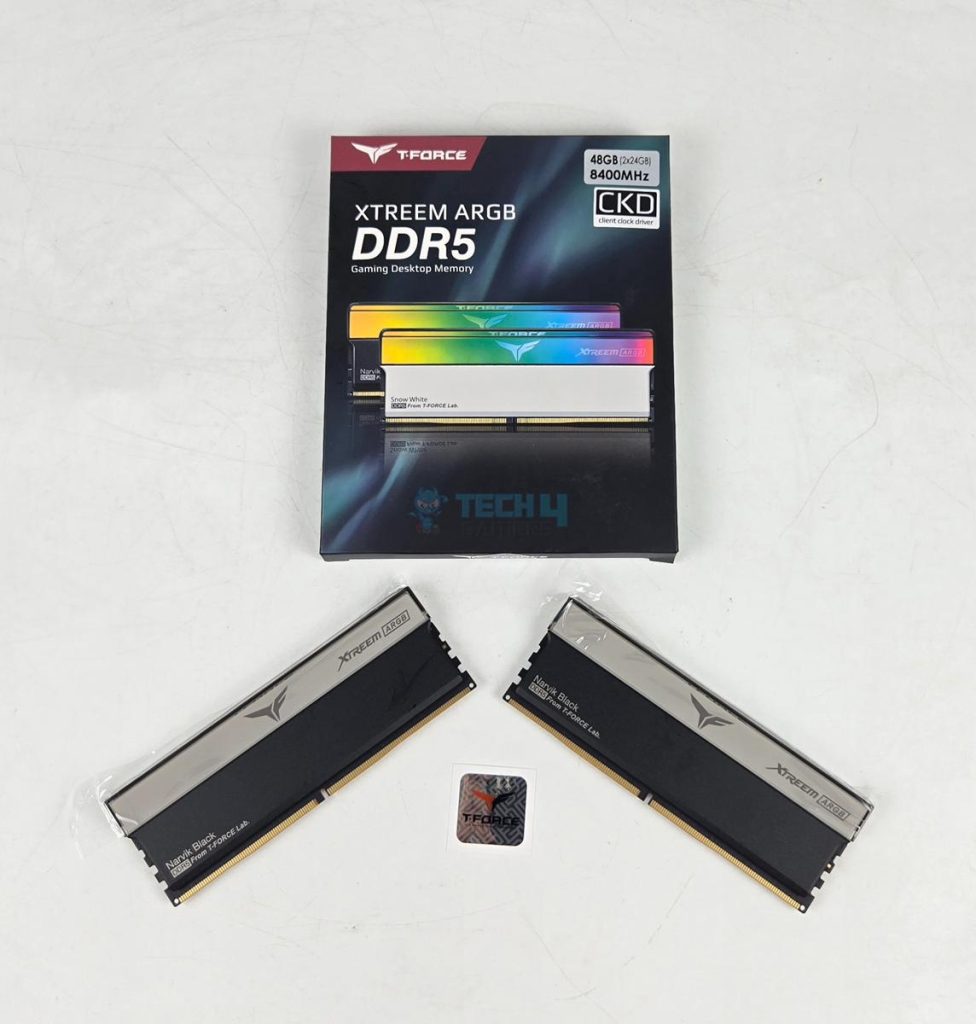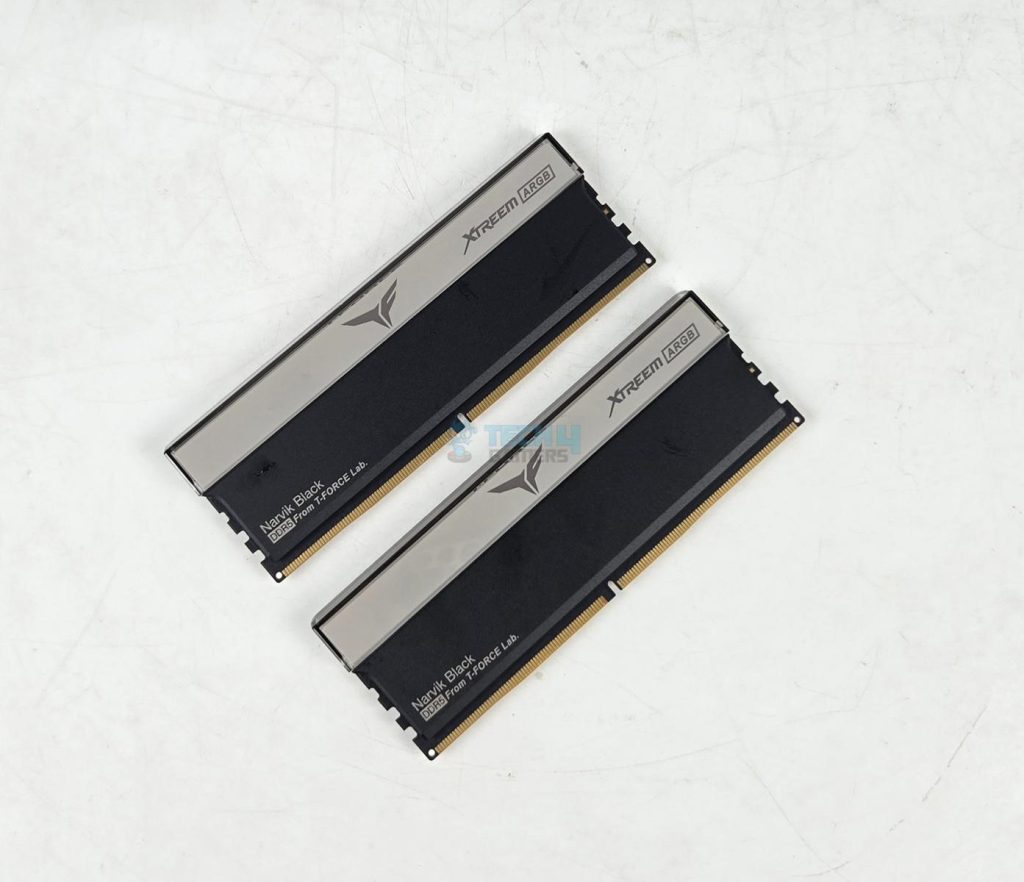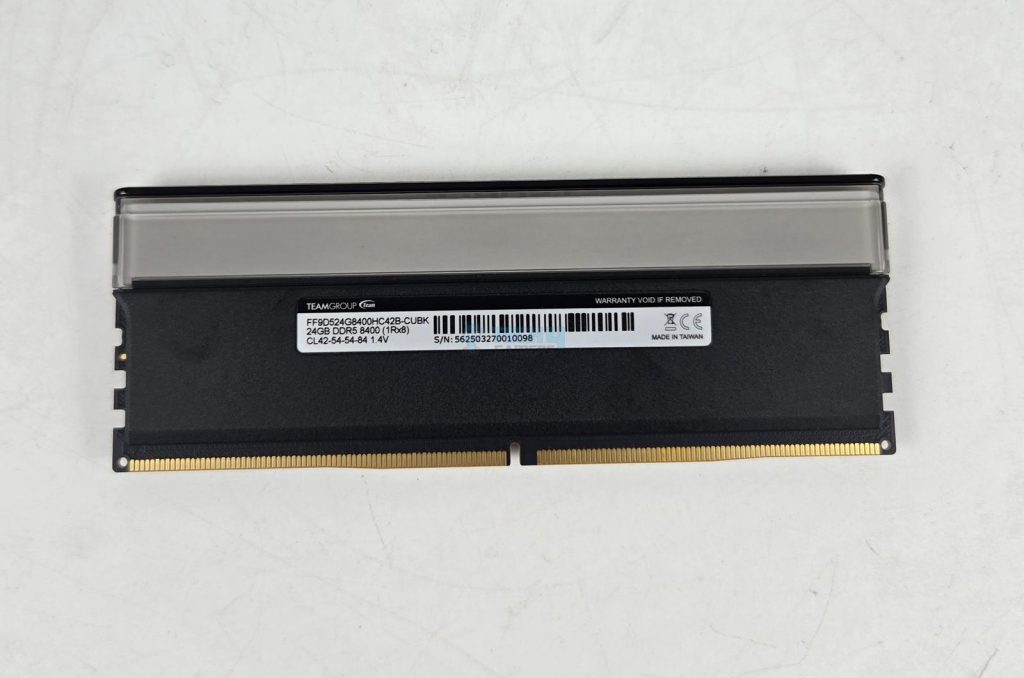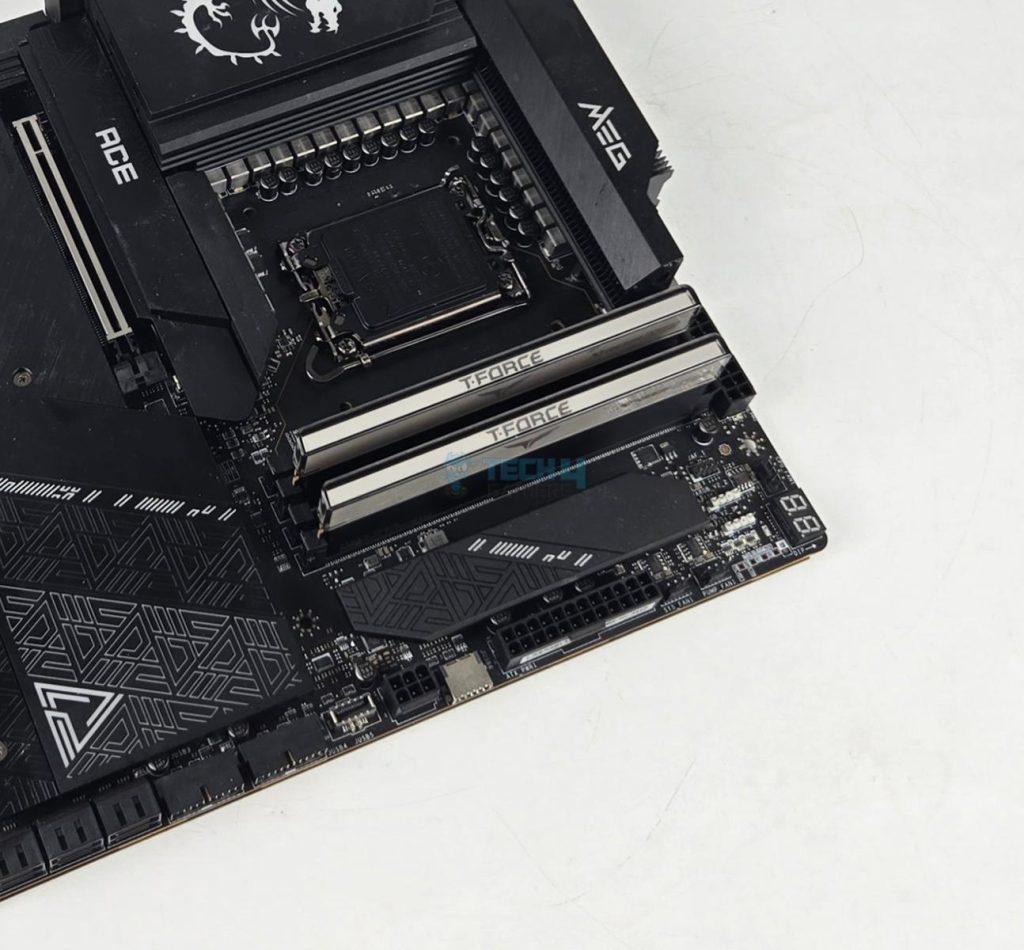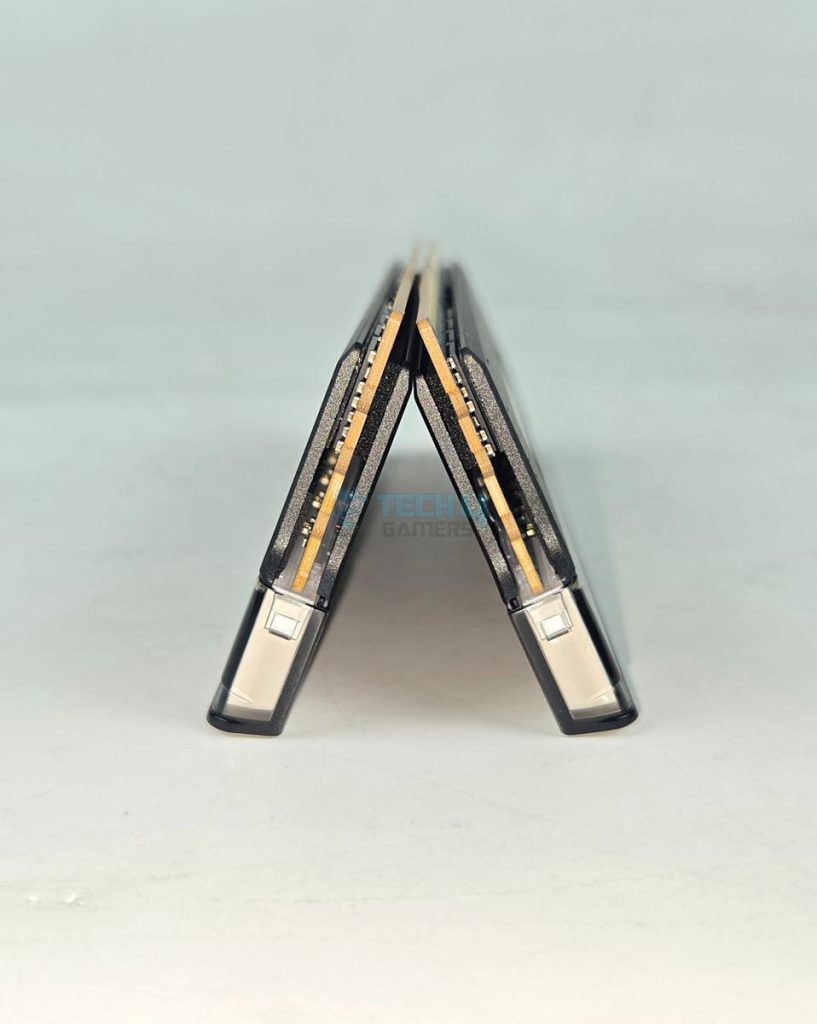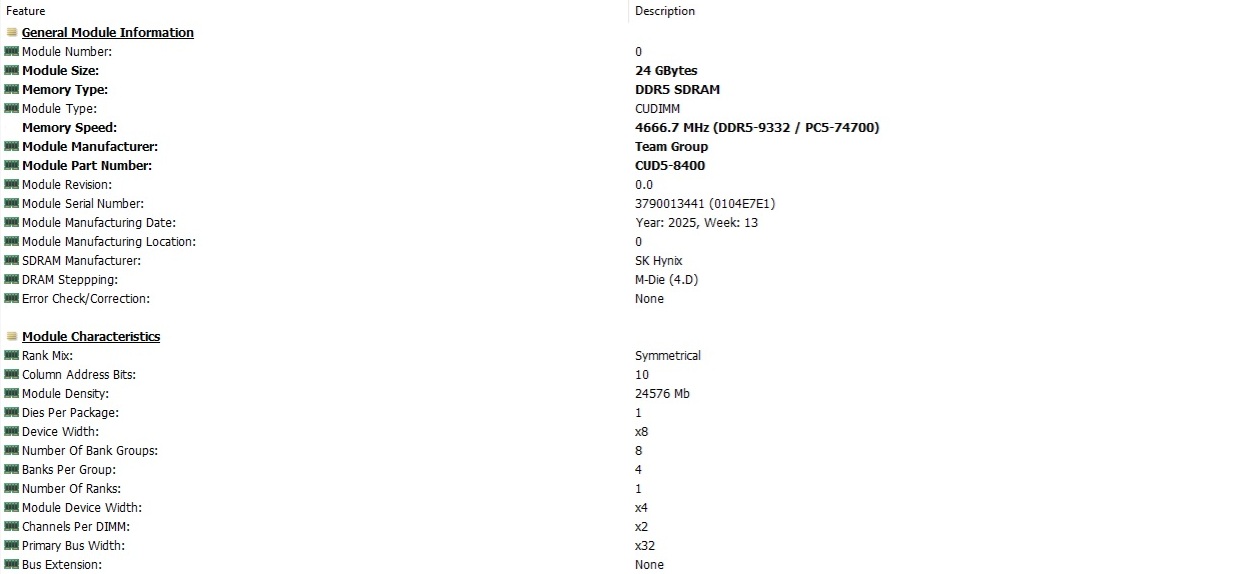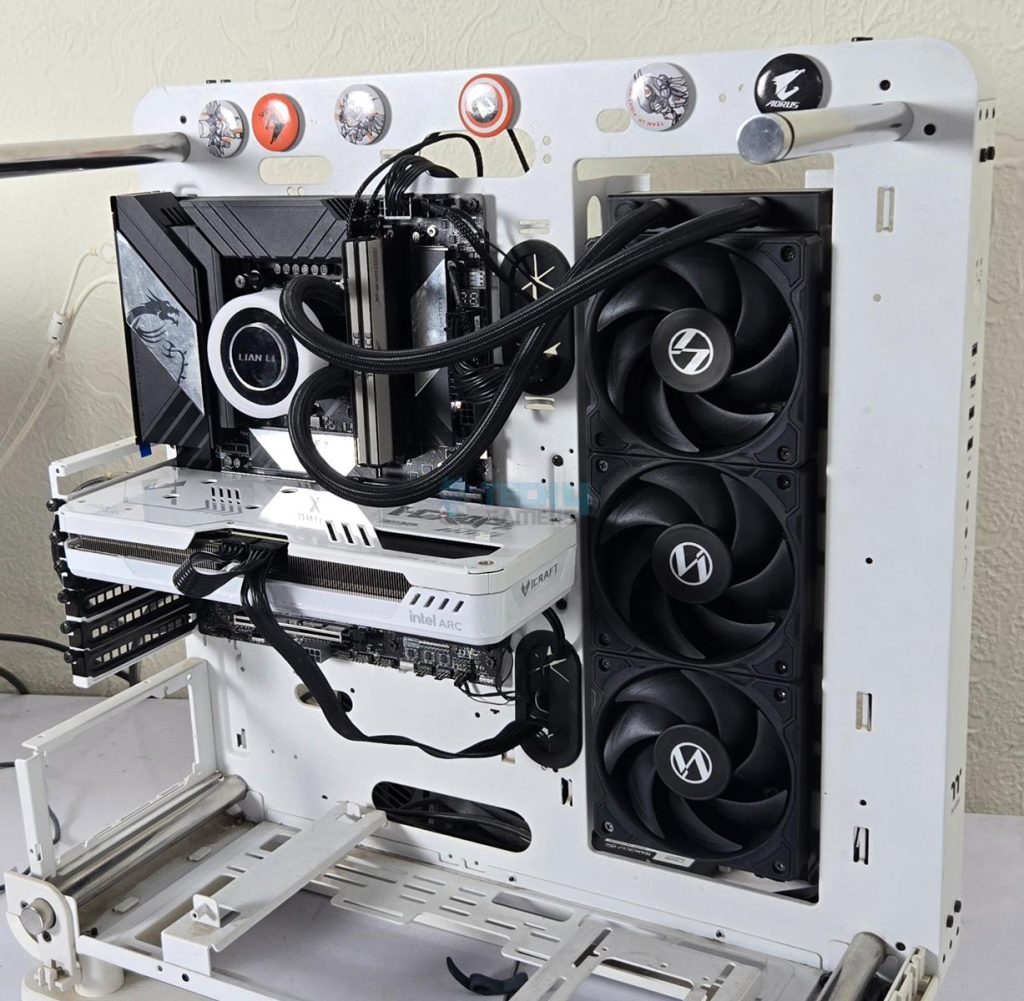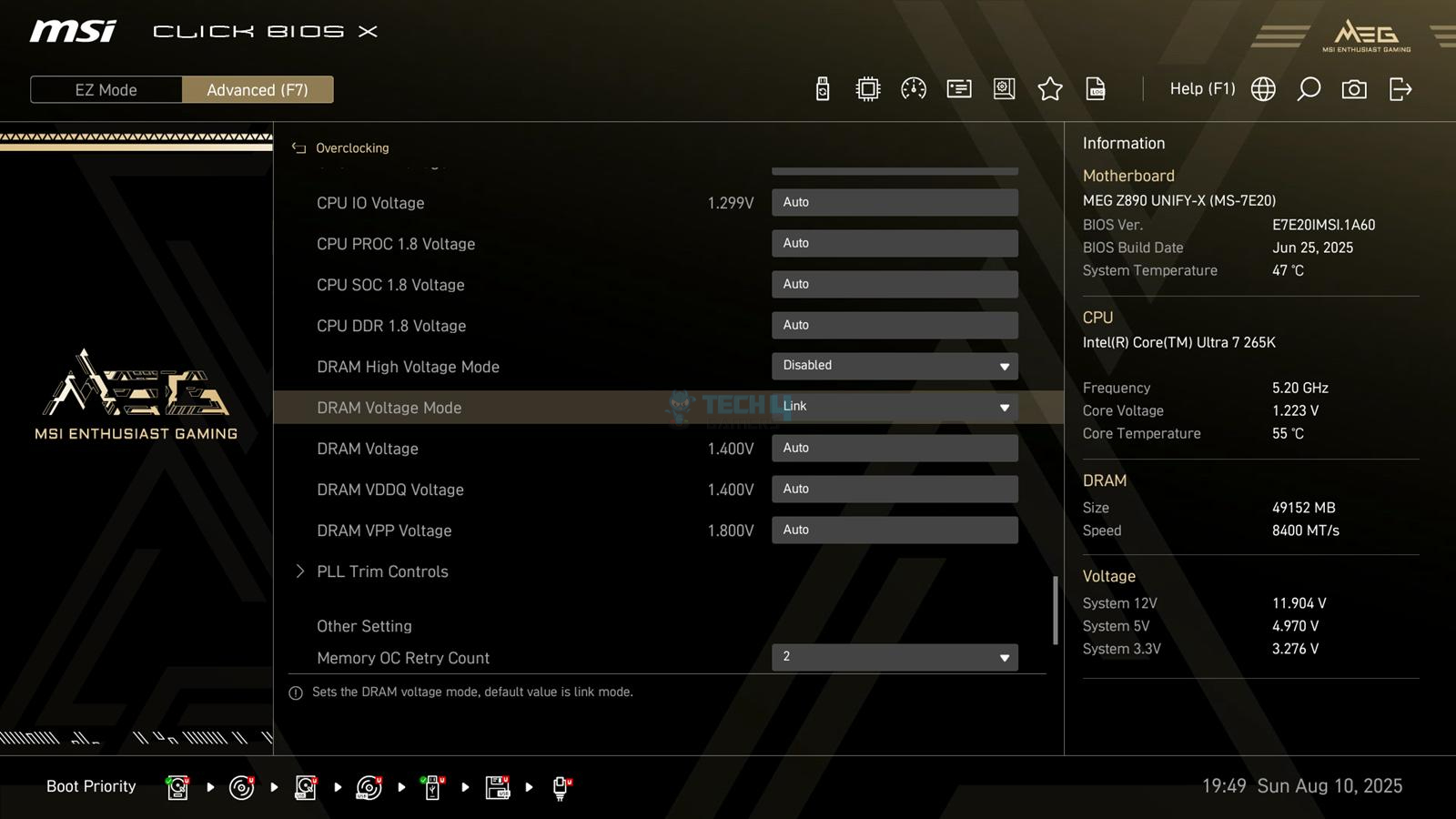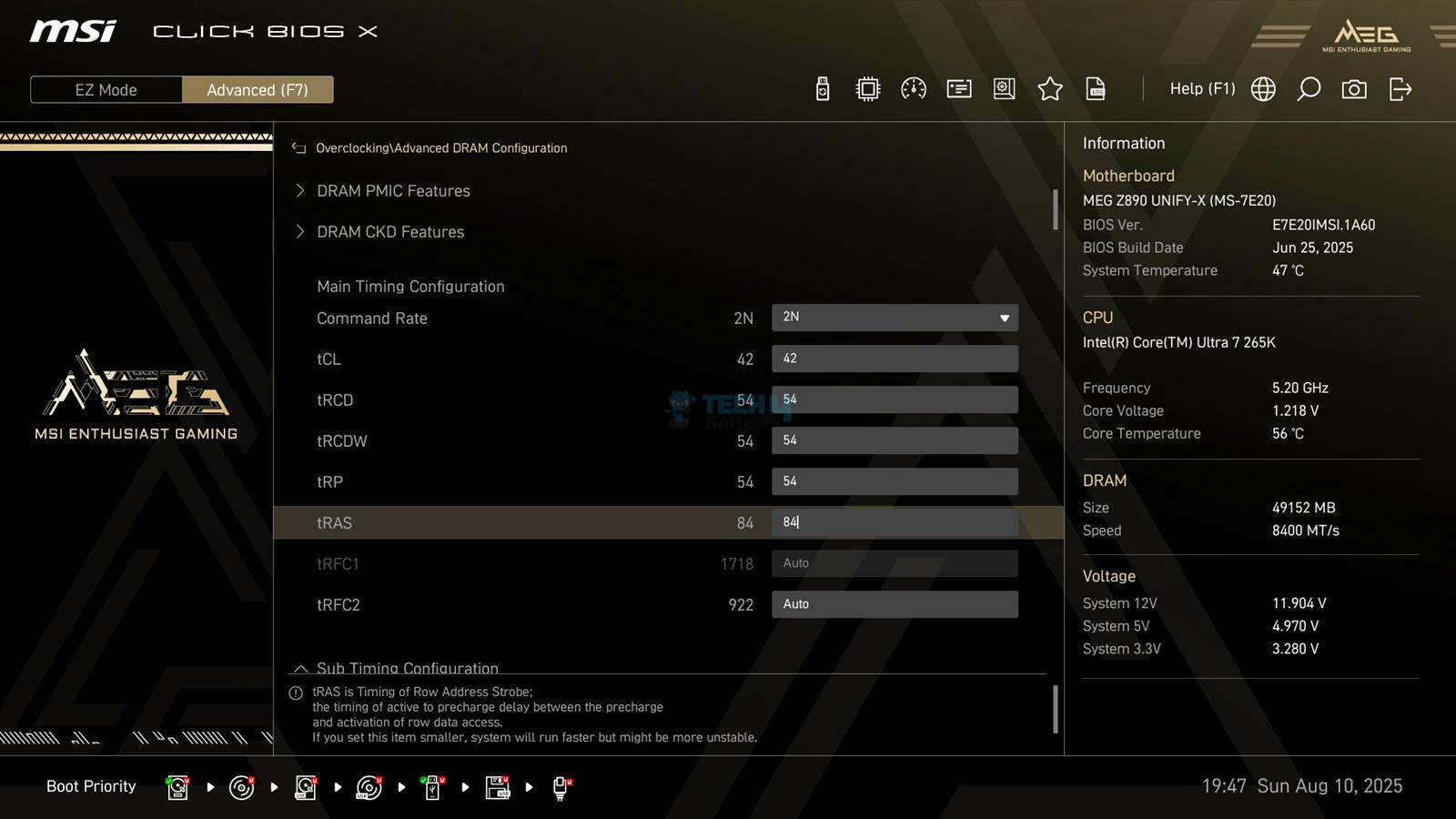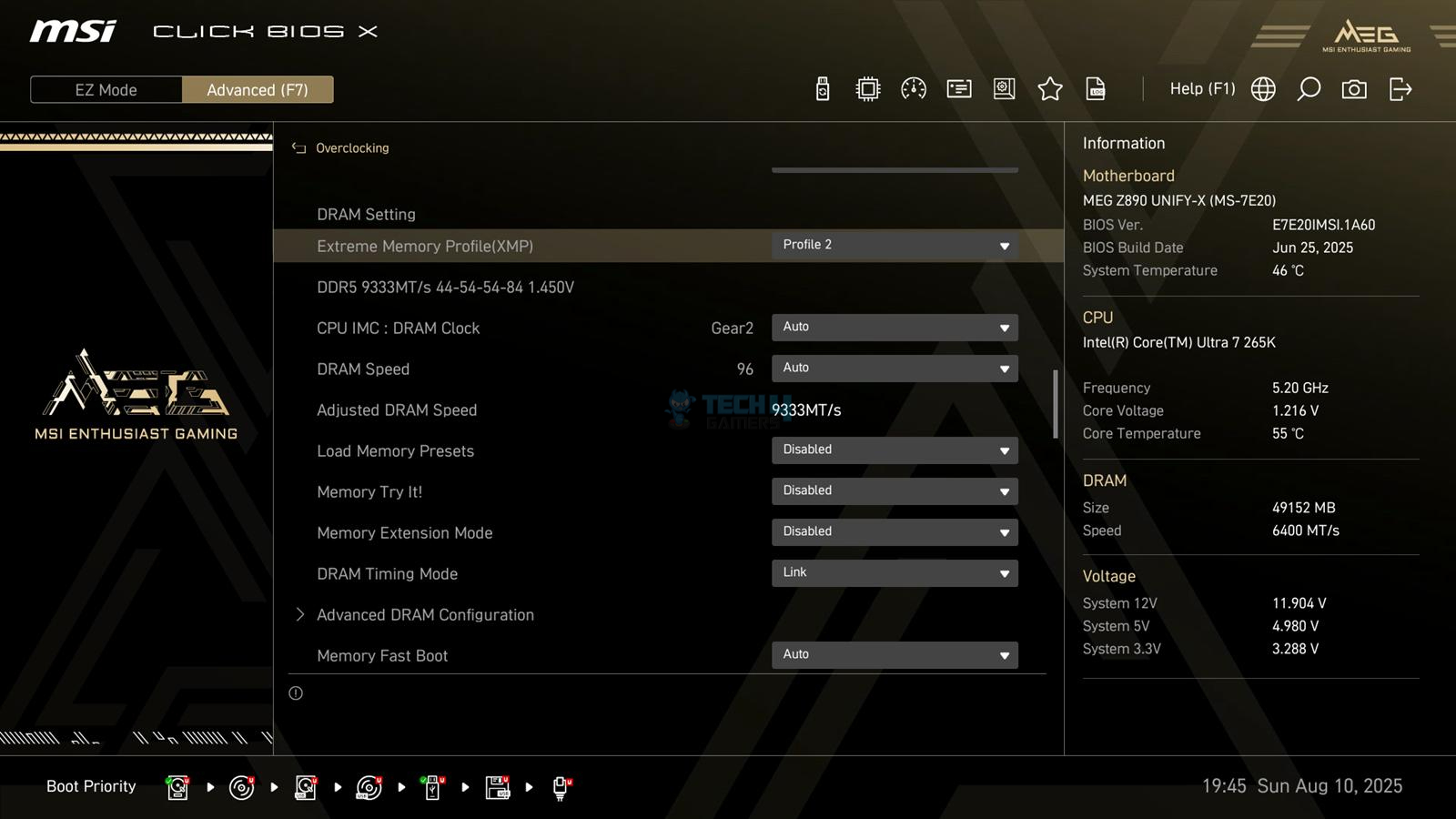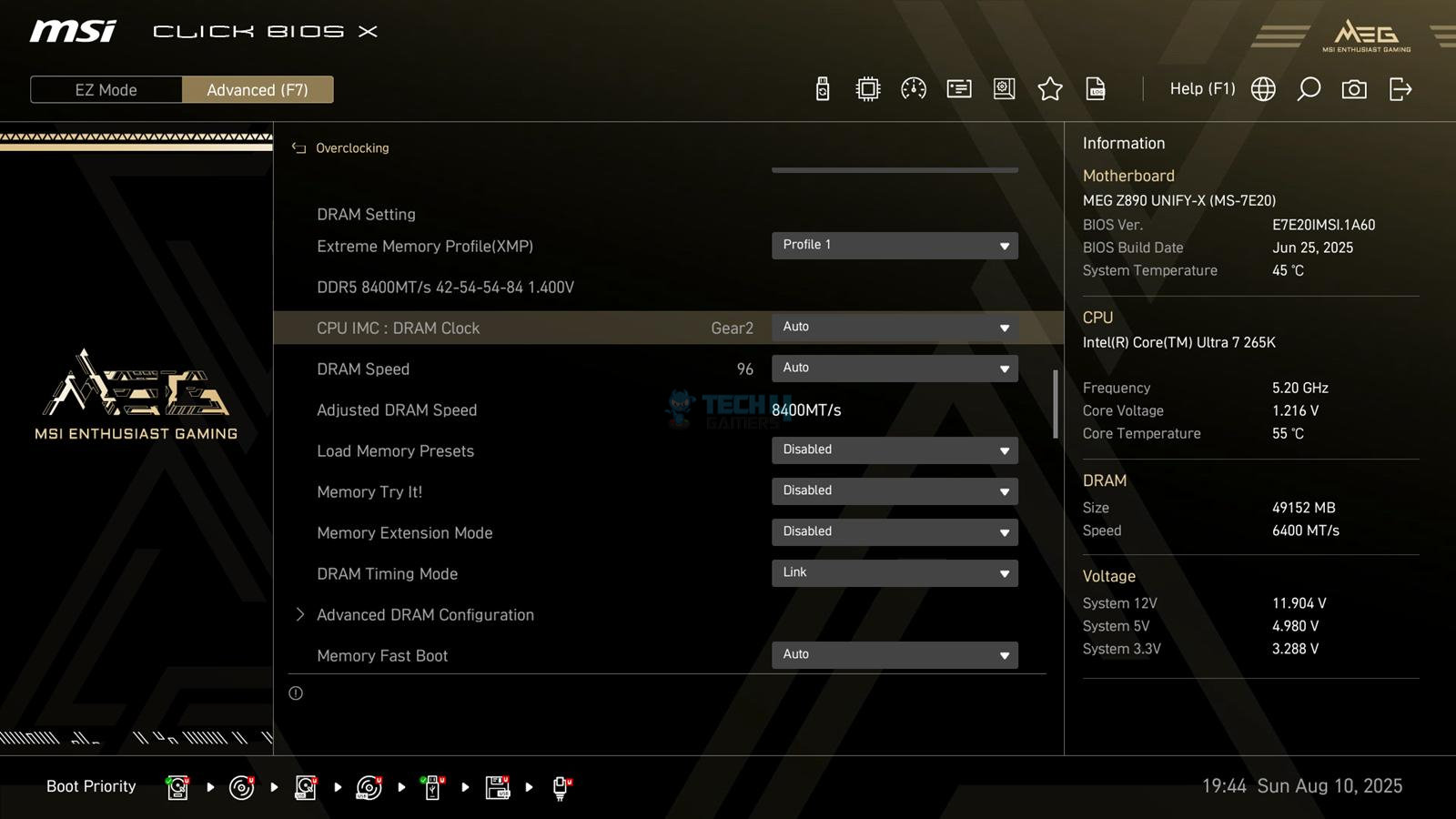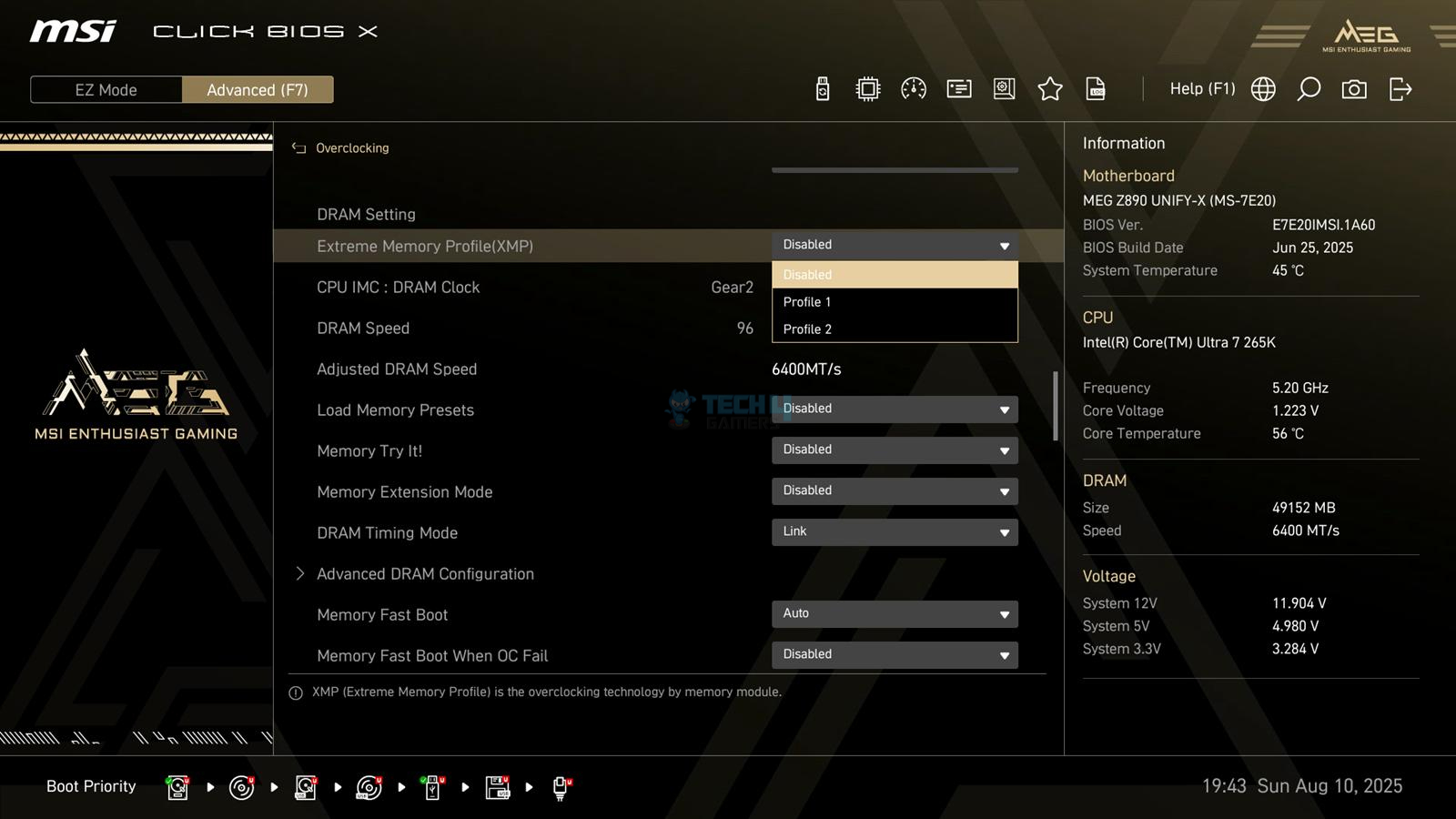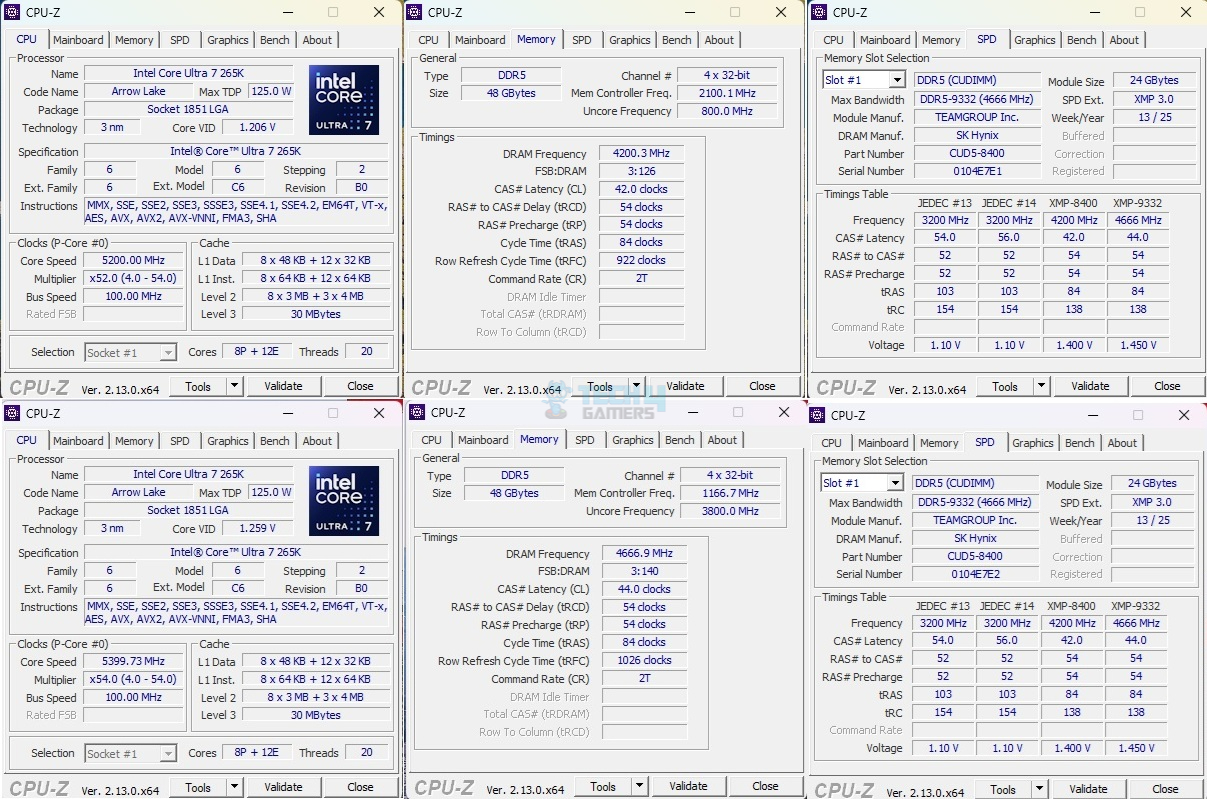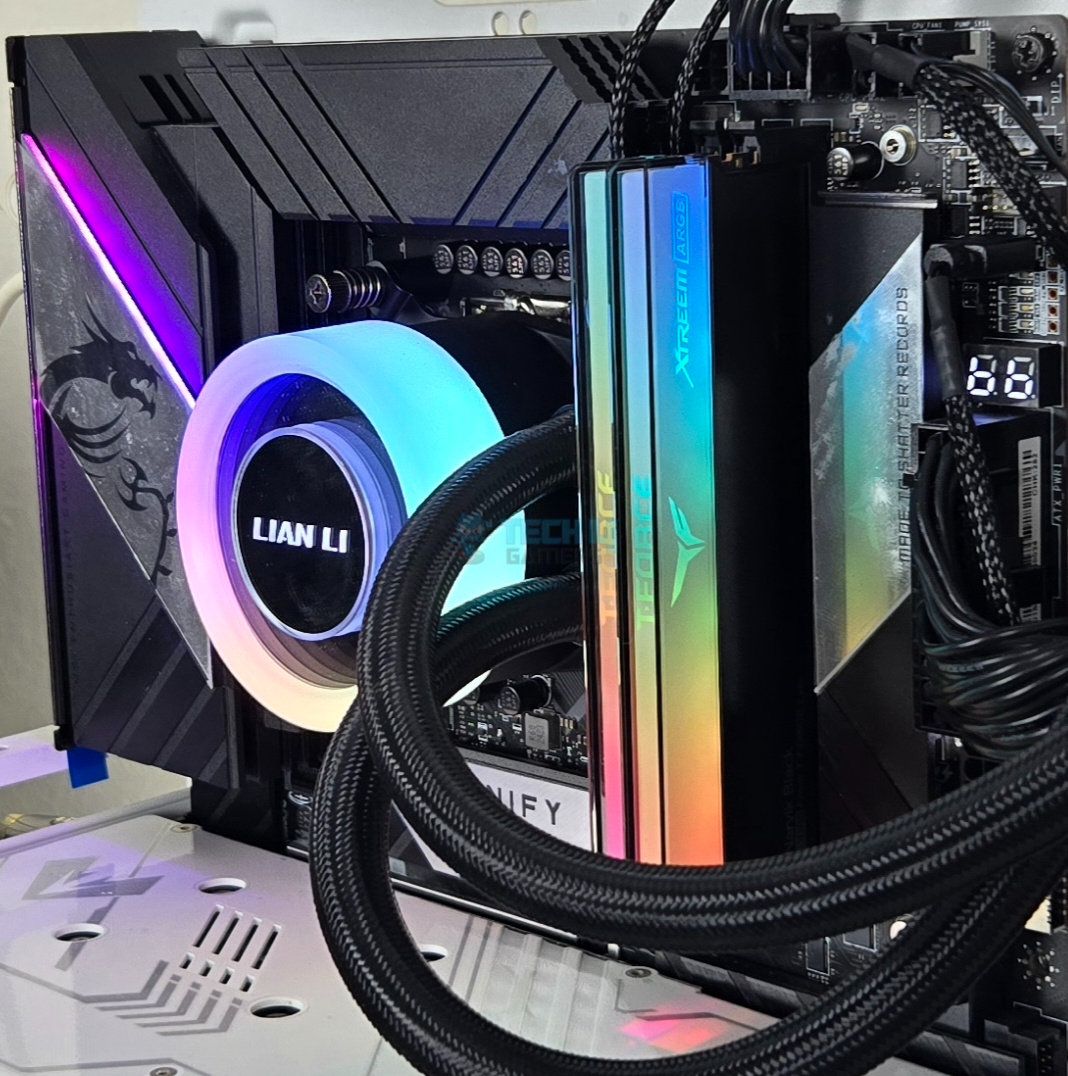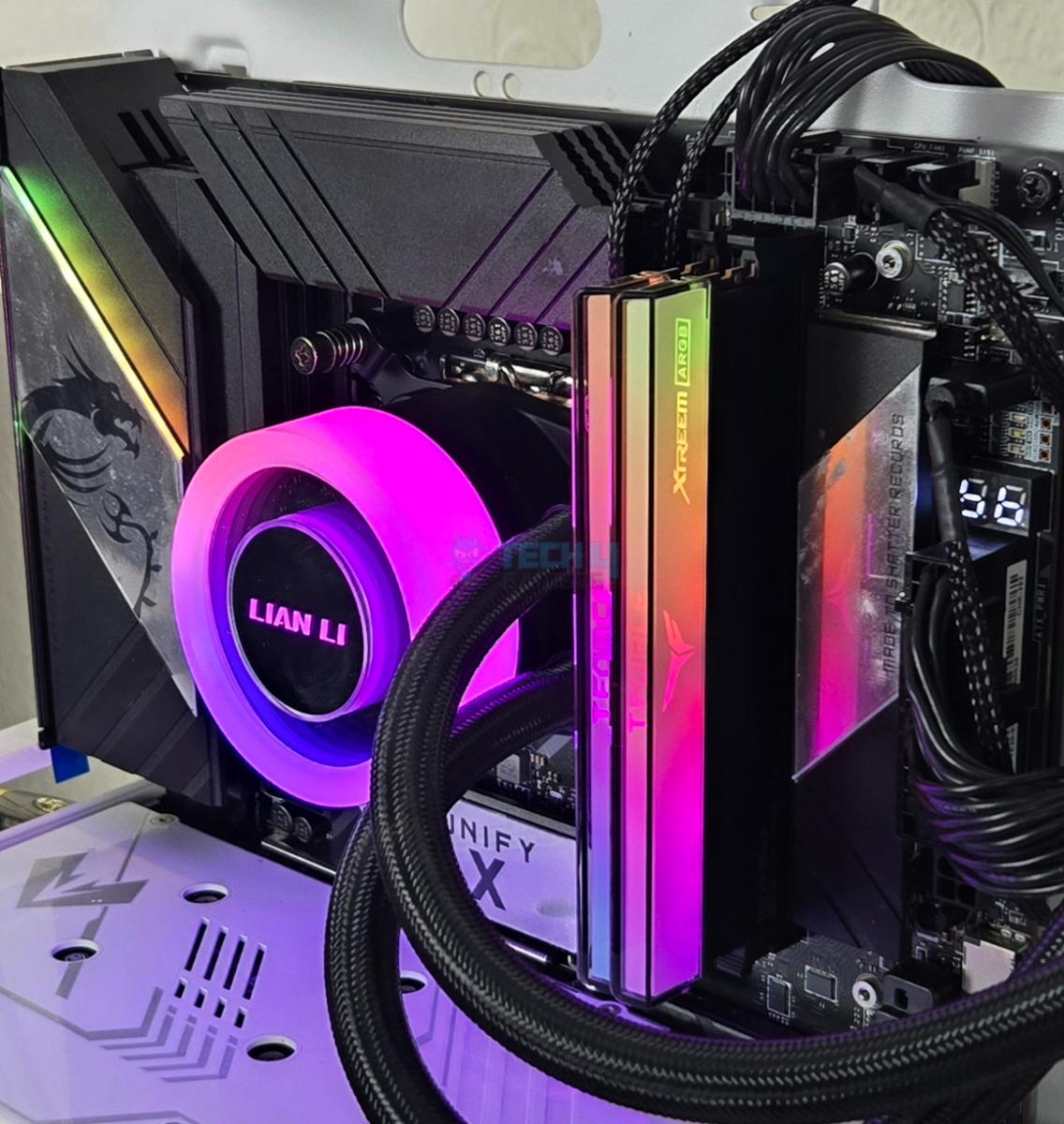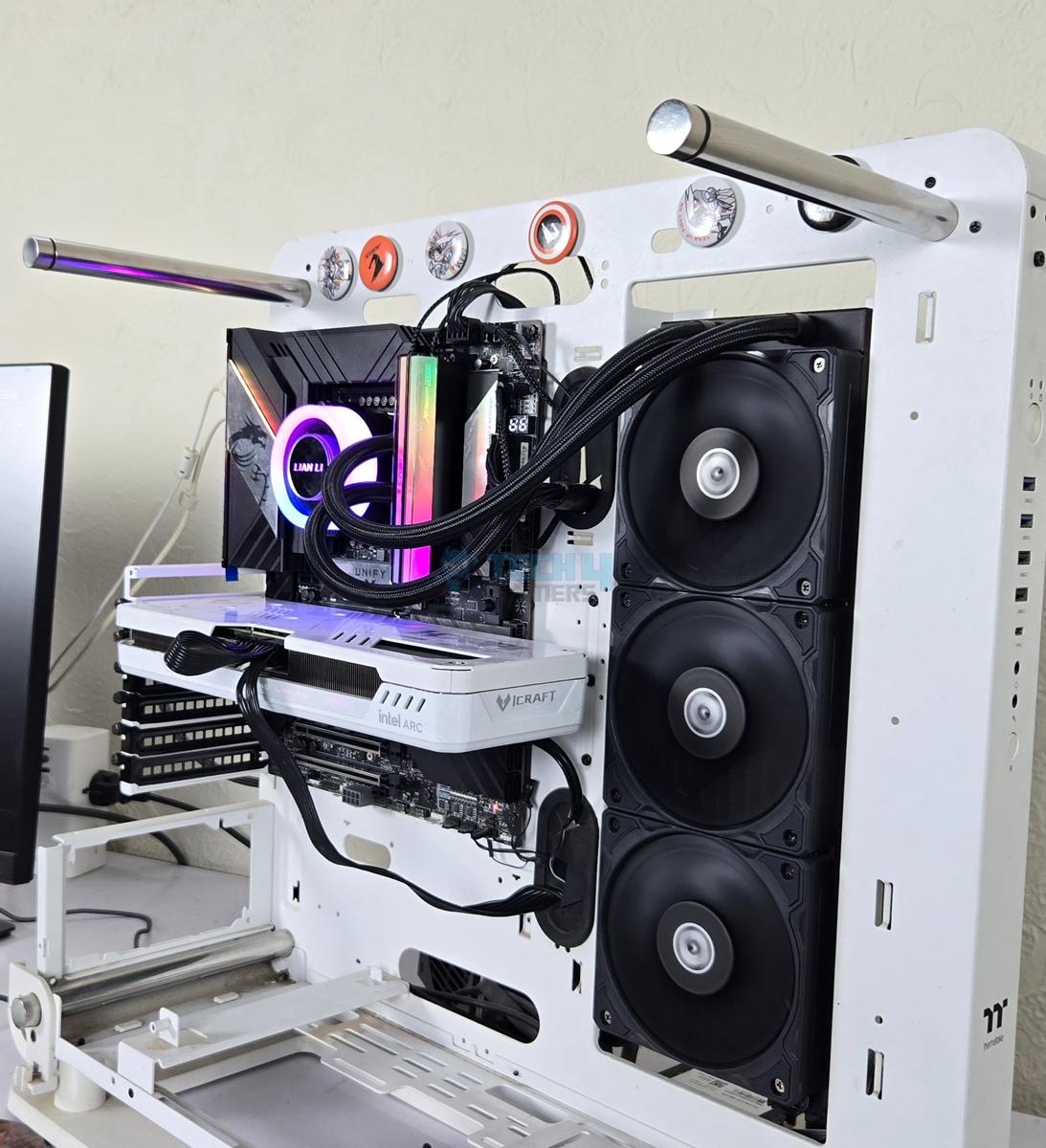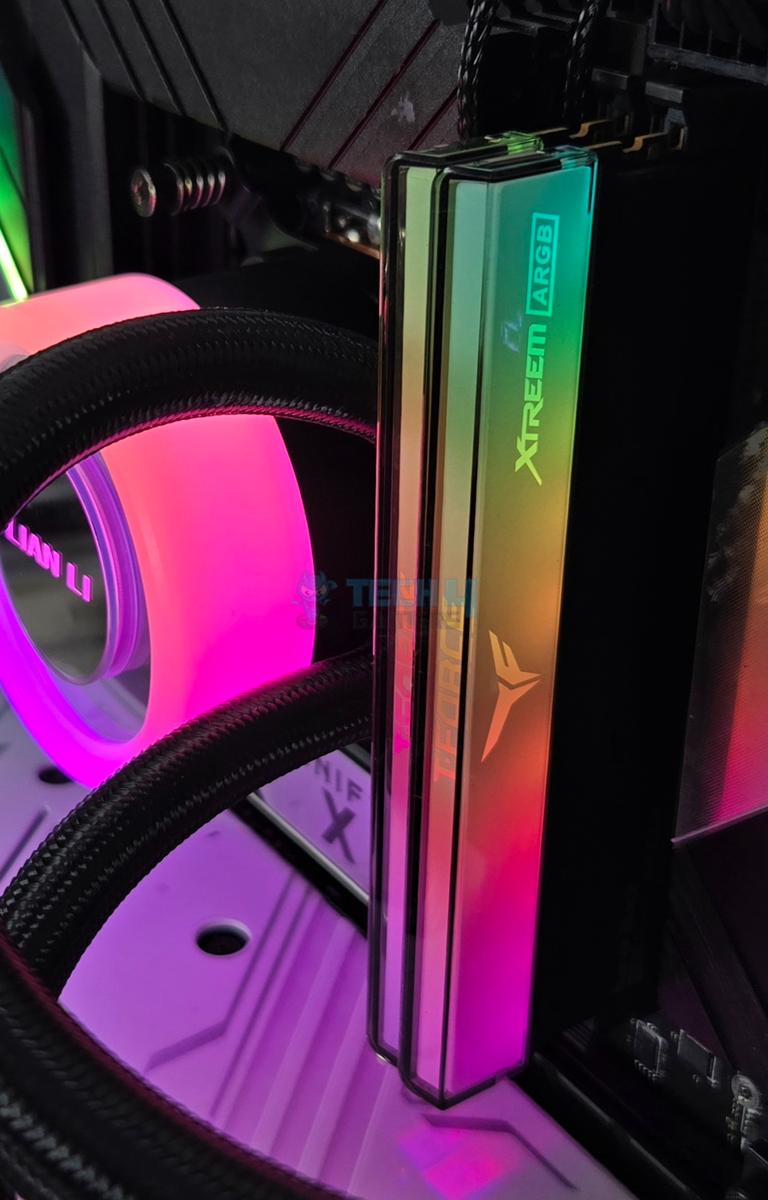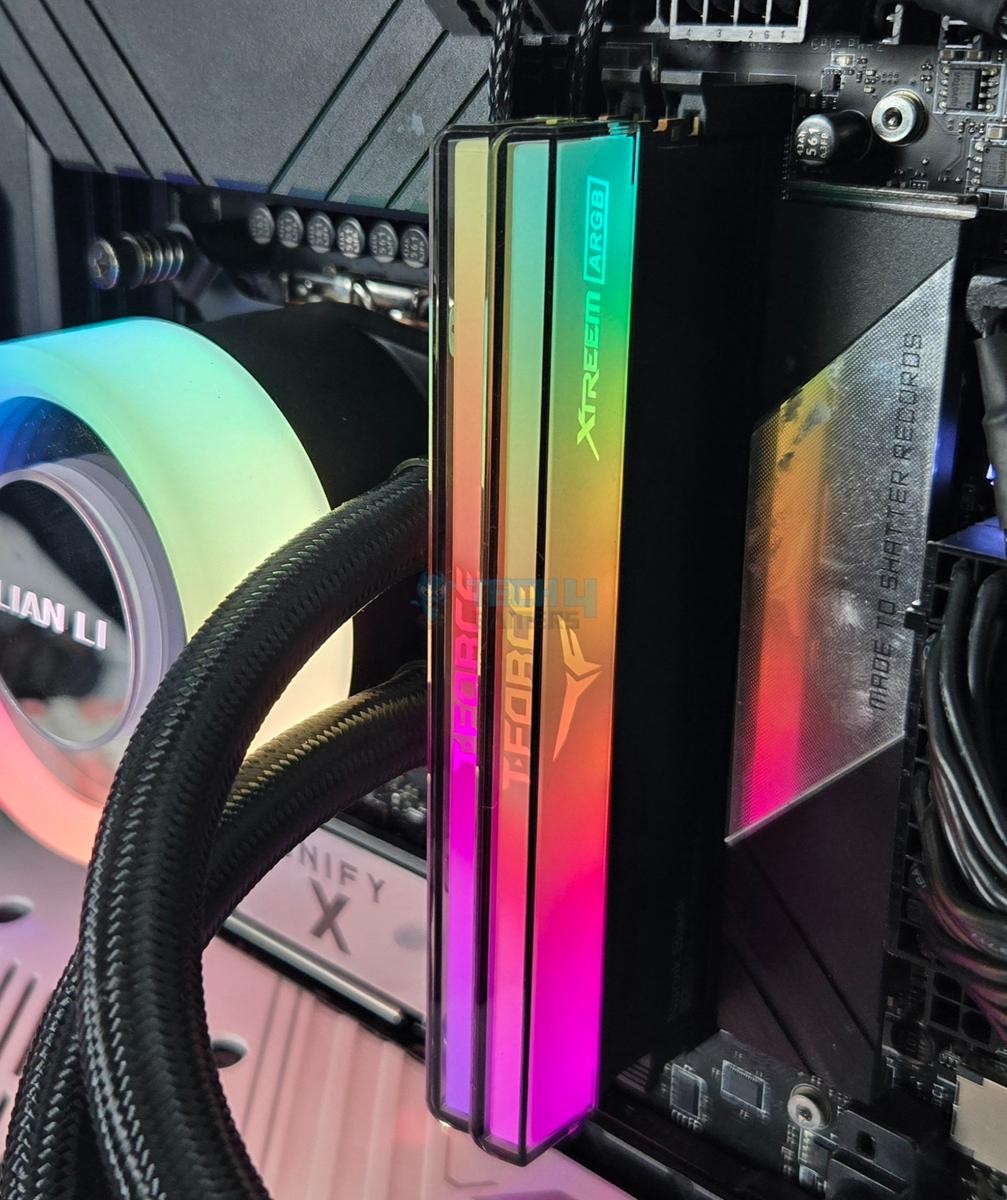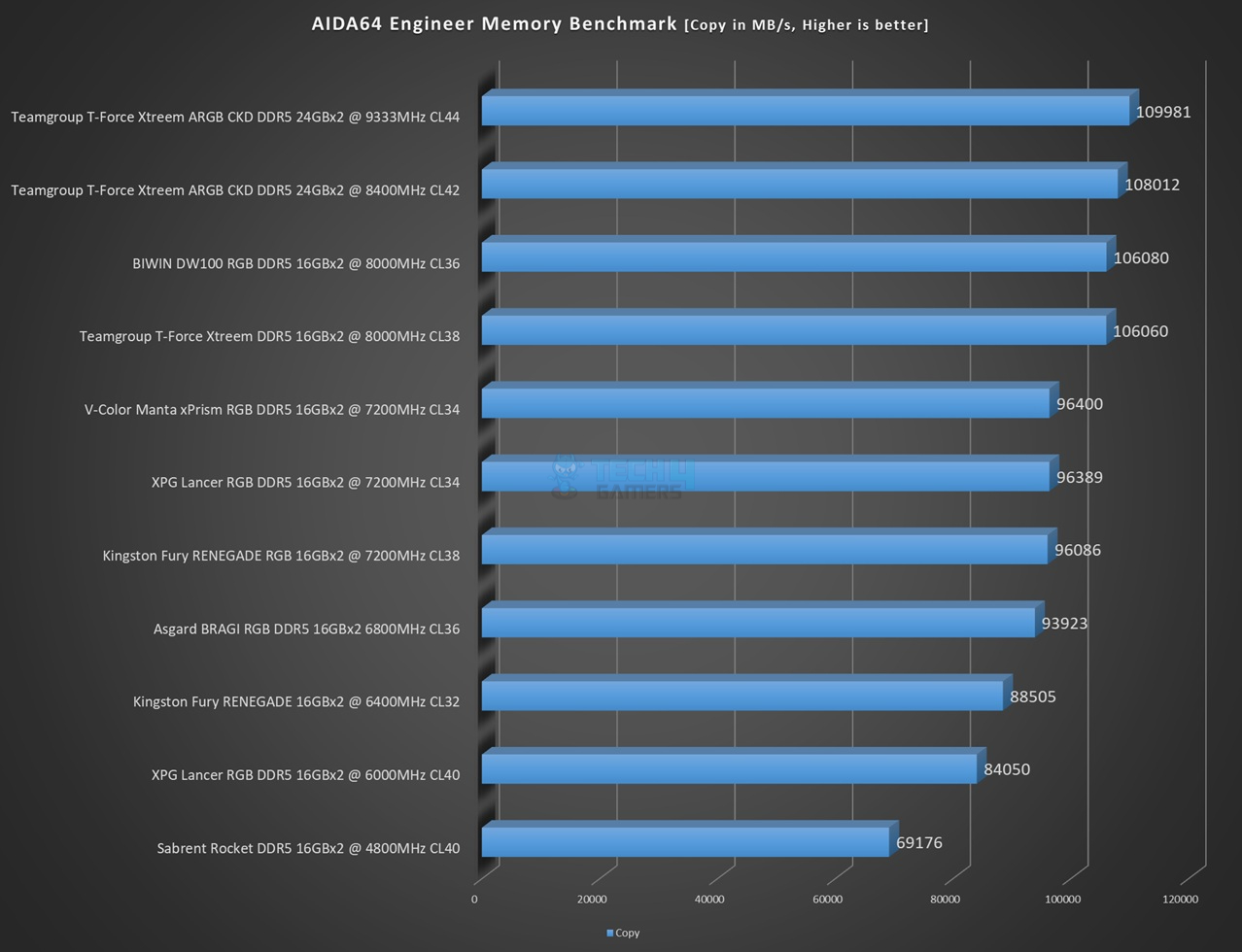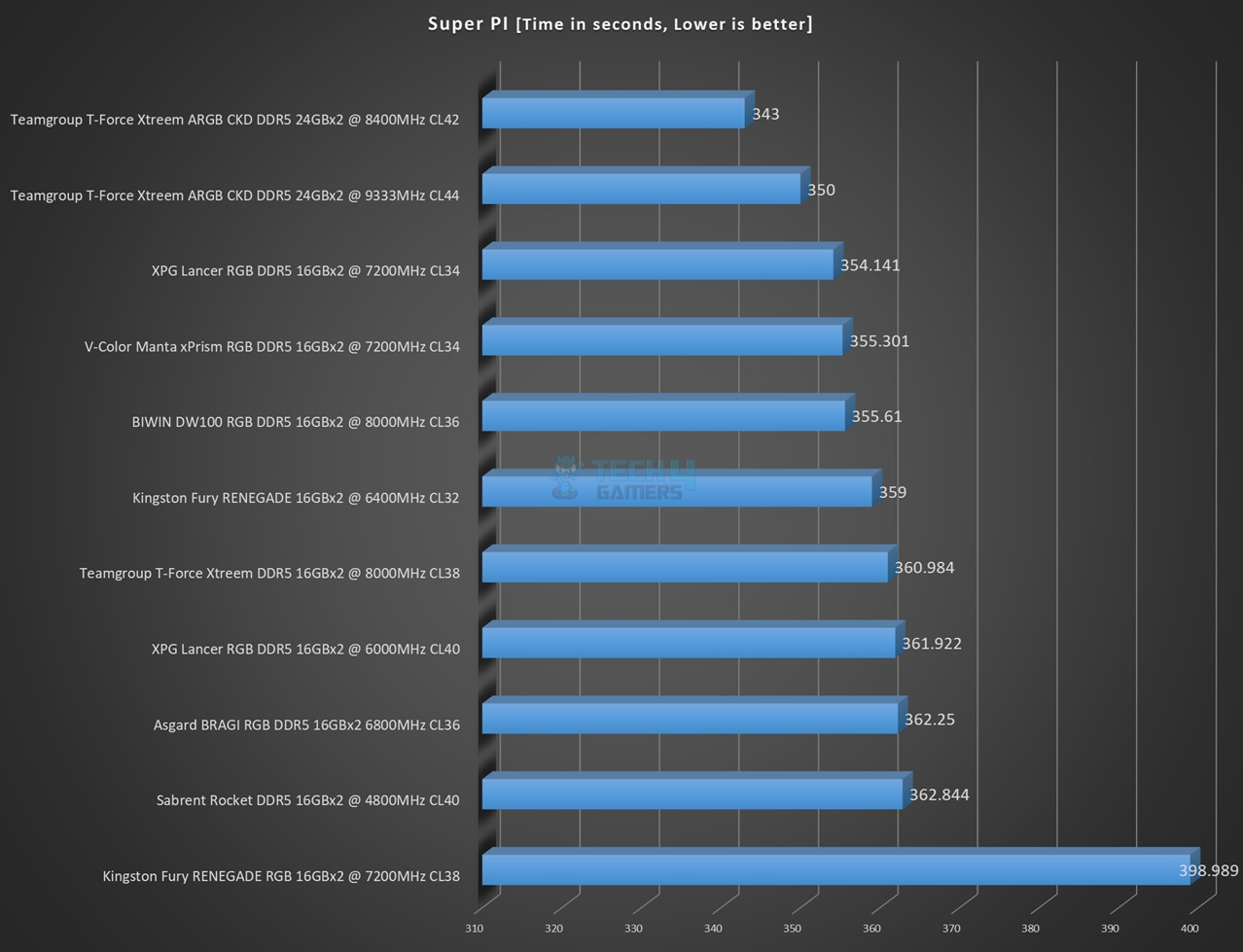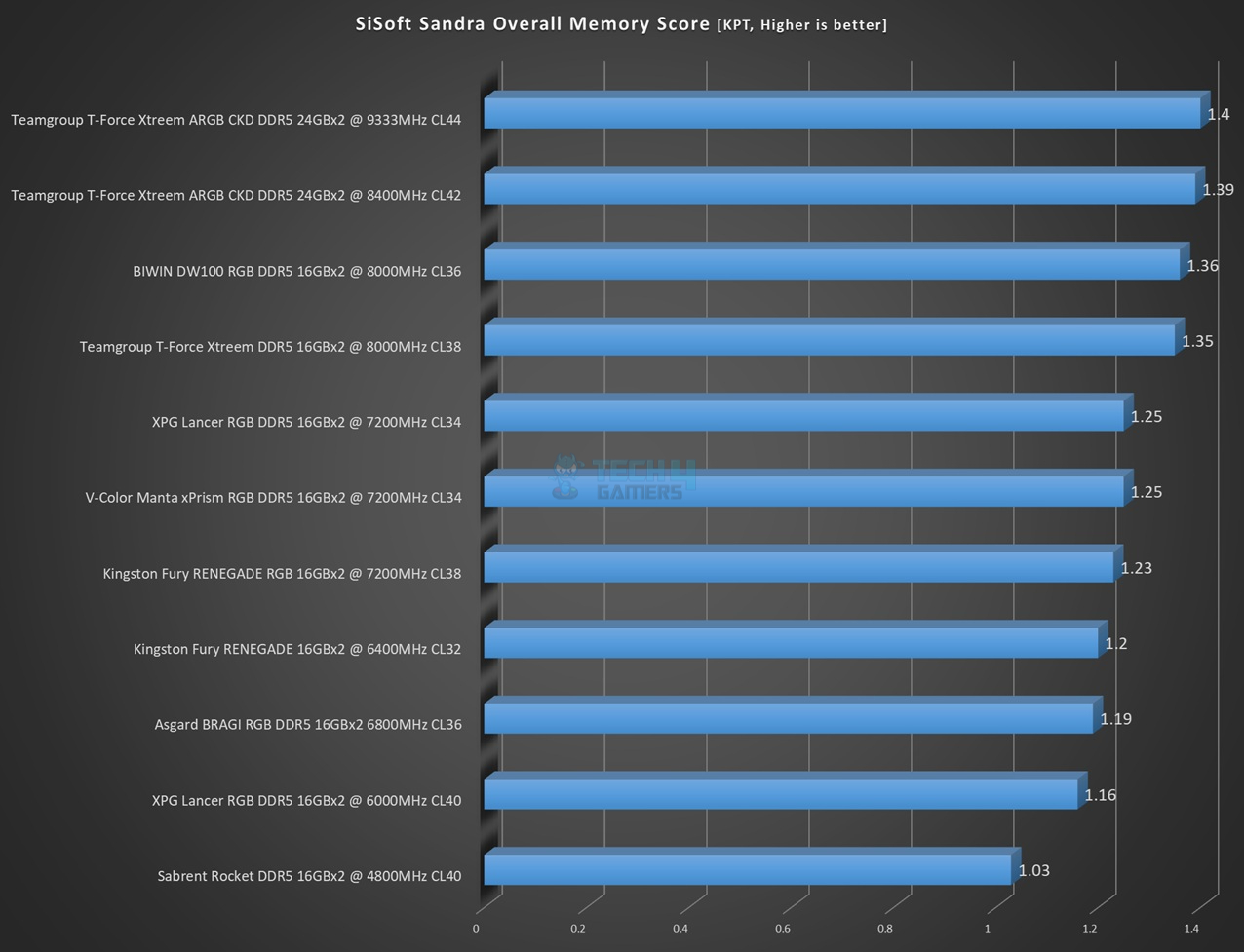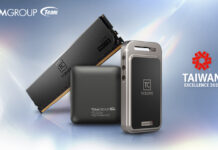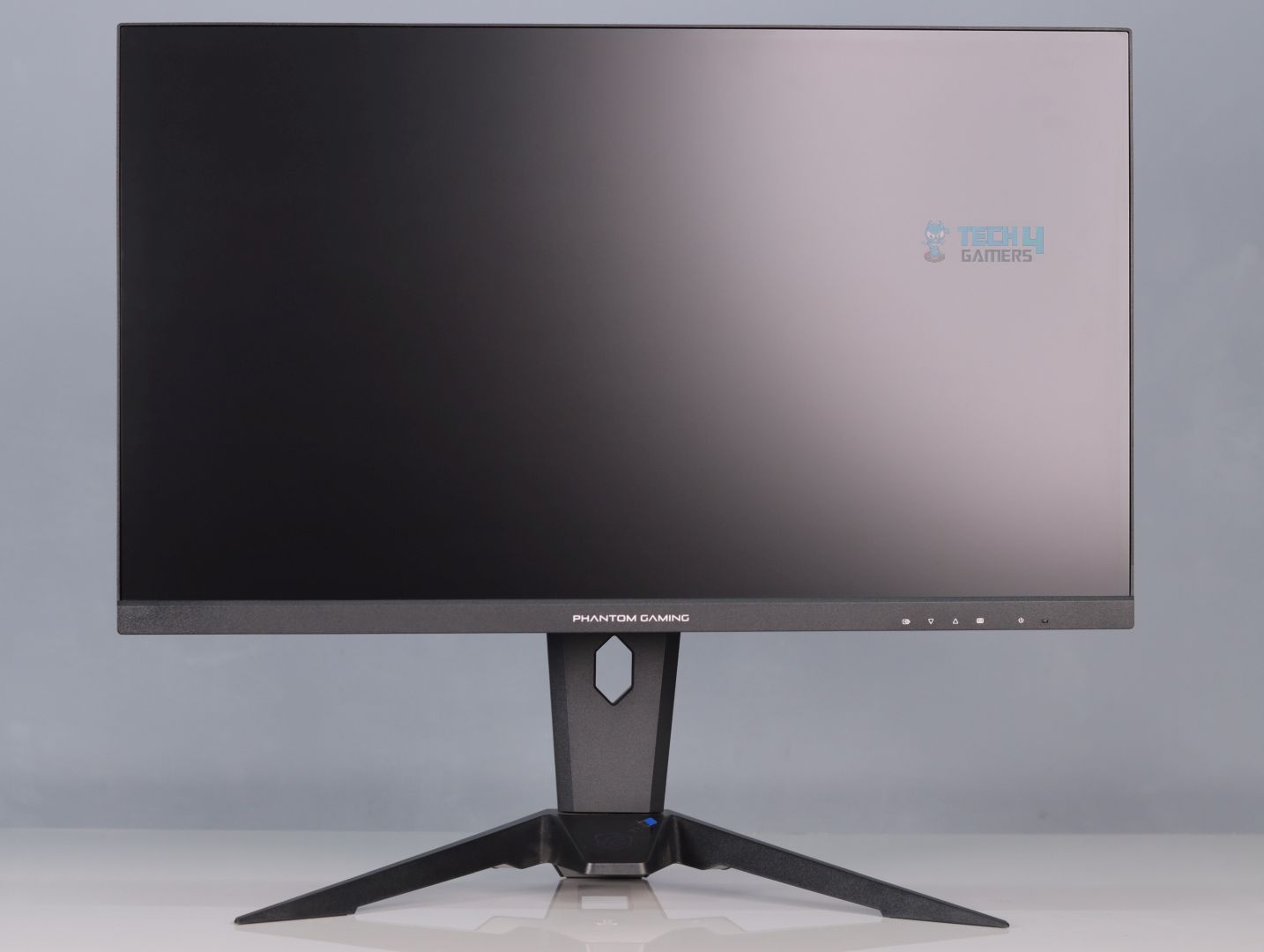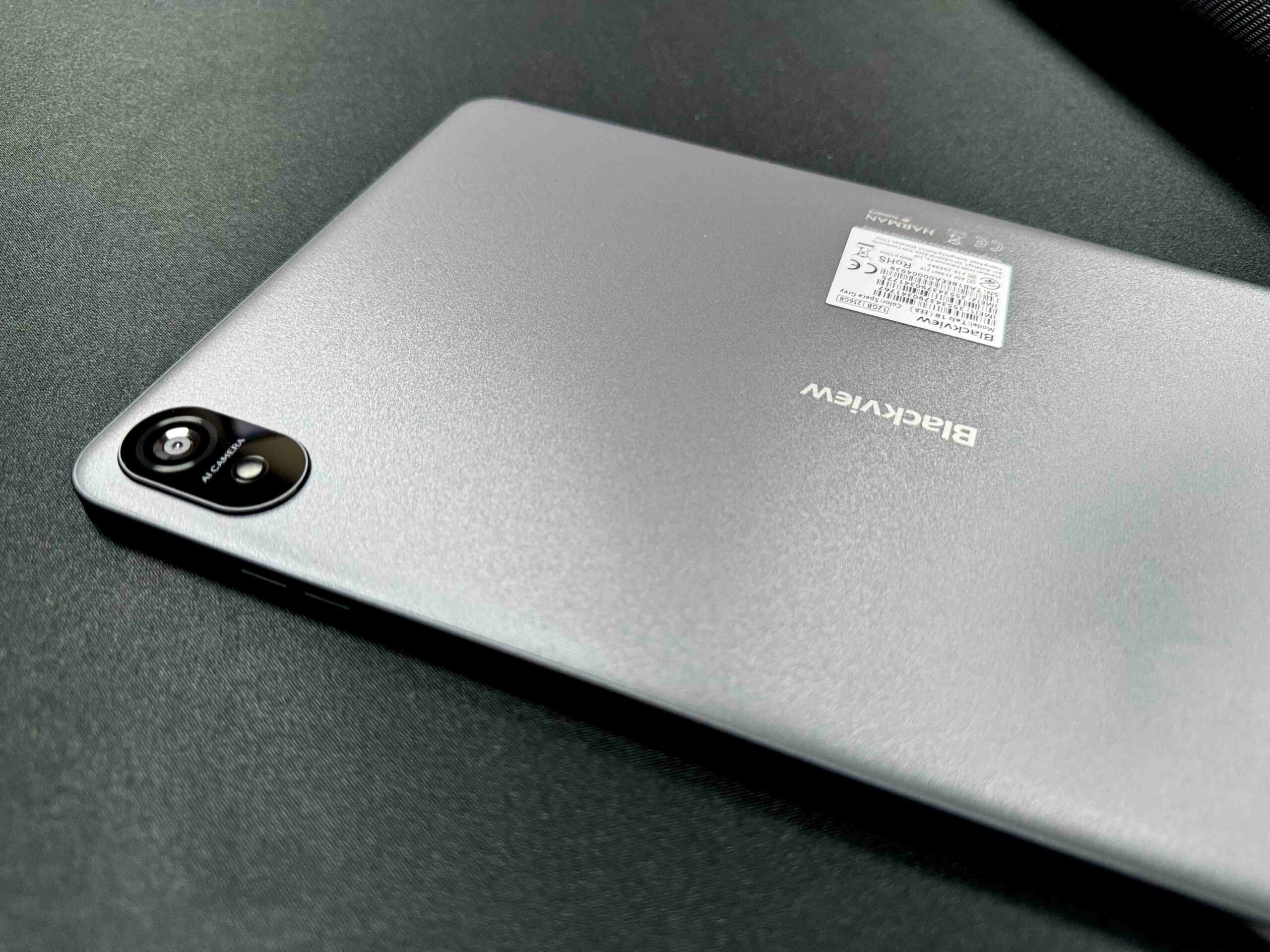Incredible Speeds!
Review Summary
The Teamgroup T-Force Xtreem ARGB CKD DDR5 kit is a powerhouse built for serious overclockers and enthusiasts, offering blazing speeds of 8400MHz and even 9333MHz out of the box, if you have the right high-end Intel Z890 hardware to unlock its full potential. With a sleek design, premium 2mm aluminum heat spreaders, vivid ARGB lighting, and on-die ECC, it blends performance, style, and reliability. While it delivers chart-topping results, its tall profile and hardware demands make it best suited for users with top-tier setups, not casual builders.
Hours Tested: 5
Overall
-
Value - 8/10
8/10
-
Performance - 9/10
9/10
-
Quality - 9/10
9/10
-
Features - 9/10
9/10
Pros
- CUDIMM
- Operates at 8400MHz, CAS42
- Second XMP profile at 9333MHz, CAS44
- Sandblasted 2mm Aluminum Heat spreader
- Vivid ARGB Lighting
- Excellent Performance
- Limited Lifetime Warranty
- Overclocking Headroom
Cons
- Height
- Limited support on 4-DIMM motherboards
DDR5 UDIMMs gained the much-deserved attention, and we are at a point where the initial high price tag issue has been overcome, with a plethora of offers available on the market from the competition. However, the overclockers were facing a barrier in achieving high frequencies, particularly over 8000MHz from regular UDIMM, though we have had a lot of success in this area.
This barrier was identified and addressed with the help of CUDIMM, a new concept that is now taking over the UDIMMs fast, though it is still in its infancy and is supported only on the Intel Z890 platform due to native architecture. The concept, simply put, is to synchronize the clock signals from the CPU MC and the DRAM chips.
This is achieved via the CKD (Client Clock Driver) IC installed on the CUDIMMs. These kits operate in either bypass mode, which means a regular DIMM behavior where there is no synchronization, or in PLL Single or Dual mode, whereby up to 4x different input and output clock pairs can be received/sent.
This allows for better signal integrity and strength, particularly at much higher frequencies where the timings are sensitive enough to disrupt the given operation. I am not going into further details as it has been extensively covered by the media.
I am taking a look at our first CKD kit from Teamgroup, which is the T-Force Xtreem ARGB CKD DDR5 kit, comprising 2x24GB modules that operate at 8400MHz, CL42 SPD. By default, this kit operates at 6400MHz, CL52.
This kit packs two XMP profiles, though only one is highlighted on the packaging box. The second XMP is even more interesting as it pushes this kit to a whopping 9333MHz, CL44. This is a non-binary kit. This kit retails at USD 279.99 at the time of this writing.
The salient specifications include:
| Memory Type | DDR5 CUDIMM |
| Capacity | 2x24GB |
| Tested Speed (XMP1) | 8400MT/s |
| Tested Latency (XMP1) | 42-54-54-84 |
| Tested Voltage (XMP1) | 1.40V |
| Tested Speed (XMP2) | 9333MT/s |
| Tested Latency (XMP2) | 44-54-54-84 |
| Tested Voltage (XMP2) | 1.45V |
| Error Checking | On-Die ECC |
| Warranty | Limited Lifetime |
| Features |
|
We have also tested and reviewed the T-Force Xtreem 48GB DDR5-8200 CL38 and the T-Force Xtreem 32GB DDR50-8000 CL38, which are some of the best DDR5 kits you can get your hands on.
What Makes This Kit Different?
Imagine running at 8400 MHz without any tuning on a supported motherboard. Now, picture hitting 9333 MHz right out of the box on a compatible board. That’s exactly what the XTREEM CKD ARGB kit from Teamgroup delivers, where fast becomes even faster.
However, there’s a catch: you’ll need a top-tier motherboard and CPU to push these kits to their full potential.
Packing Box
The kit comes in a black color packaging box made of paperboard. There is a mention of XTREEM ARGB CKD DDR5 on the box. The memory modules are nicely tucked inside the transparent container.
Design
Let’s start by stating the salient features of the kit:
- The kit has two XMP 3.0 profiles
- The Kit features CKD IC
- The kit has On-Die ECC Correction
- There is a meticulously layered, aluminum sandblasted fin structure
- The Aluminum Alloy Heat Spreader has a thickness of 2mm
- Limited Lifetime Warranty
- A power management chip for stable and effective power usage
Teamgroup has retained the basic footprint of the Xtreem series DDR5 kits on this ARGB CKD kit. One of the two differences externally would be a stylish ARGB diffuser/cover on the top, and the absence of the futuristic T-Force brand logo in silver over the ARGB CKD kits.
The gray and black colors synchronize well and give a stylish outlook to the modules. The heat spreader is made of sandblasted aluminum alloy material. This heat spreader has a 2mm thickness with a layered design using multiple fins to efficiently transfer the heat.
Narvik Black is printed over the base, indicating the color of this kit. This kit is from T-Force Lab, which I am sure is a marketing tagline since all of their kits are rigorously tested in their lab.
A sticker is pasted on the back, removing which voids the warranty. The part number of this kit is FF9D524G8400HC42B-CUBK. A serial number, speed, timing, and voltage ratings are also printed.
This kit is an unbuffered DIMM with a 288-pin layout. Each module has 1Rx8, meaning a single rank design using 8 modules. These kits are made in Taiwan. These kits have on-die ECC, which comes in handy for real-time data correction. This kit has dimensions of 48.8×134.5×8.2mm (HxLxW).
Looking at the top of this kit, you can see a stylish finish. A glass cover is placed over the top. The T-Force brand logo is in the center. The complete gray area is ARGB backlit. The top has an angled design or a slope design, which is not apparent in the picture. This kit, for some reason, blends perfectly over the MSI ACE motherboard.
This kit seems to have a 10-layer PCB design. The PCB color is black, which is standard on these DDR5 modules. One side of this is populated with the ICs and active circuitry, whereas the opposite end is blank and has a thermal pad of the same thickness to make the PCB sit in between the heat spreader evenly.
There are 4x memory chips on the left of the integrated PMIC chip and 4x memory chips on the right side of this controller. This gives a 24GB capacity overall in 1Rx8 using a 3G x 64-bit design. A key difference is the placement of the thermal pad over the PMIC.
I have used HWInfo64 to read some hardware data since Thaiphoon burner could not read the bus. Memory chips are M-Die from SK Hynix. The PMIC controller is from Richtek, having a part number of PMIC5100. This kit is manufactured in the 13th Week of 2025. The CKD device is obviously from Rambus, having a type of DDR5CKD01.
This kit has two Intel XMP Revision 3.0 profiles programmed. Profiles are:
- 8400MHz 42-54-54-84 1.40V
- 9333MHz 44-54-54-84 1.45V
The SPD device SPD5118 is from Renesas.
Testing
We are using below mentioned configuration for RAM testing:
- Intel Core Ultra 7 265k [Stock, Auto]
- Lian Li GA-II Lite 360 Performance
- MSI Z890 Unify-X
- Sabrent Rocket 4 Plus 1TB PCIe 4.0 NVMe SSD [For OS]
- Intel Arc B580 [For Display]
- Fractal Design ION+ 2P 860W Platinum PSU
- Thermaltake Core P6 TG Snow Edition in an open frame layout
The following software has been used for the testing:
- AIDA64 Engineer
- SiSoftware Sandra Suite
- Performance Test
- 3DMark Time Spy
- Super Pi
BIOS Run
This kit has two Intel XMP 3.0 profiles. CKD does not work on the AMD platform in PLL mode; hence, no EXPO profile is on this kit. The XMP2 seems to be off with some programming. I had to manually enter the timings to get to work. I have tested the kit on both XMP profiles, and both are listed in the graphs.
CPU-Z
The above is a CPU-Z screenshot. Looking closely, you will notice that the software is reporting the kit to be in quad-channel configuration. The reason is that with DDR5 kits, we have two channels per module, with each being 32-bit wide.
RGB Lighting
I appreciate the ARGB lighting on this kit. Teamgroup has done a fantastic job in this department as well. This kit is compatible with the RGB sync technology of motherboard manufacturers.
Test Results
This is our first kit in the graph operating at 8400MHz.
AIDA64 Engineer
The overall result of the CKD kit operating at 8400MHz and 9333MHz is superb. Although the latency on the second XMP profile is higher but it is expected. See editor’s note below.
Other Benchmark Software Results
We have mixed results from other test software. The Super PI has shown a good performance from this kit. However, overall memory score from SiSoft Sandra and performance tests are marginal. The same goes for the CPU score from the Time Spy Extreme.
You need to disable the Intel 200S update to make the kit work above 8000MHz, as this mode locks the kit at 8000MHz. In my testing, I have seen that the manual overclock up to 9000MHz using Gear 2 mode has given much stable performance, albeit marginally less performance than the speeds over 9300MHz using Gear 4 mode. The key here is stability. The performance metrics on 9333MHz or higher using Gear 4 mode are not that substantial.
To push these kits to their limits, you need the best hardware, comprising a capable motherboard like MSI Z890 Unify-X and a CPU with good MC. You can say you are dependent on the silicon luck after all, at least for the CPUs. I had a tough time with this kit on ASRock Z890 NOVA WiFi, as that motherboard could not handle speeds beyond 8,800 MHz. I am now arranging Intel Core Ultra 9 285k to continue playing with this kit for more results.
– Nauman Siddique
Should You Buy It?
Buy It If
✅You want nothing but the best: The CKD kits are the next big thing, and the T-Force XTREEM ARGB CKD DDR5 kit operating at 8400MHz/9333MHz, CAS42/44 with 48GB is best in class.
✅You have a high-end motherboard with good IMC: You are very much in luck if you have a golden CPU and a powerful motherboard for the CKD kits.
✅Subtle RGB is also your need: This kit has a black layout with gray color over the top area, which is covered by a glass top. You easily get the best ARGB light show on this kit.
Don’t Buy It If
❌RAM Clearance is an issue: This kit has a height of 48.8mm. This is quite a tall profile and could be problematic for the air coolers.
❌Your hardware can’t handle CKD kits: At present, you need to have a powerful motherboard with a capable CPU (MC) to handle the CKD kits to achieve higher frequencies. Do your homework before spending on this kit.
Final Words
CUDIMM or CKD DDR5 kits are the next big thing in the PC industry. Teamgroup offers a solid range of CKD kits, available in both RGB and non-RGB editions, across multiple frequency ranges. I had the opportunity to test the T-Force XTREEM ARGB CKD DDR5 kit, which is the manufacturer’s second-best flagship offering. These kits are far from ordinary, which is why their target market is enthusiasts, overclockers, and professionals.
In my opinion, gamers and regular desktop users are better off with non-CKD kits. They could save a considerable amount by skipping CKD kits and instead put that money toward a high-quality graphics card.
The tested kit includes two XMP profiles: one operating at 8400 MHz with timings of 42-54-54-84 at 1.40 V, and the other at 9333 MHz with timings of 44-54-54-84 at 1.45 V. It uses M-die from SK Hynix, CKD IC from Rambus, SPD from Renesas, and PMIC from Richtek.
Unsurprisingly, this kit topped all my benchmark charts. It’s the first and only kit on my test bench to run at both 8400 MHz and 9333 MHz. Measuring 48.8 × 134.5 × 8.2 mm (H × L × W), it features a 2 mm aluminum-alloy heat spreader for efficient heat dissipation. The onboard ECC die is a welcome addition, providing extra peace of mind.
This kit comes with a limited lifetime warranty and retails for USD 269.99.
Thank you! Please share your positive feedback. 🔋
How could we improve this post? Please Help us. 😔
[Hardware Reviewer & Editor]
Meet Nauman Siddique, a highly experienced computer science graduate with more than 15 years of knowledge in technology. Nauman is an expert in the field known for his deep understanding of computer hardware.
As a tech tester, insightful reviewer, and skilled hardware editor, Nauman carefully breaks down important parts like motherboards, graphics cards, processors, PC cases, CPU coolers, and more.
- 15+ years of PC Building Experience
- 10+ years of first-hand knowledge of technology
- 7+ years of doing in-depth testing of PC Hardware
- A motivated individual with a keen interest in tech testing from multiple angles.
- I majored in Computer Science with a Masters in Marketing
- Previously worked at eXputer, EnosTech, and Appuals.
- Completed Course in Computer Systems Specialization From Illinois Tech


 Threads
Threads
